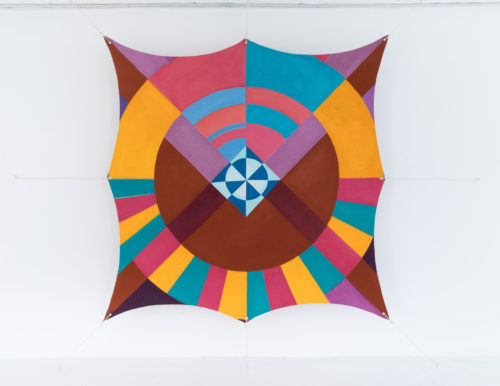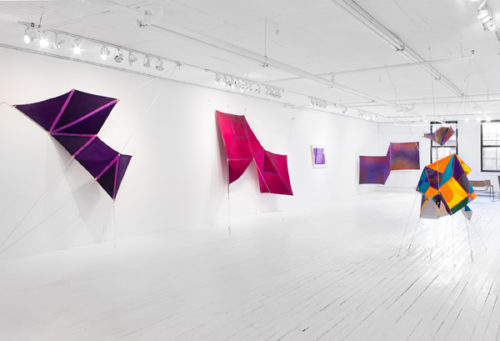Joe Overstreet’s spectacular flock of paintings from the early ‘70s presented at Eric Firestone Gallery masterfully deploy modern painting principles as flight instruction laden with social meaning. The physical feat of flying starts with moving forward. The exhibition’s multi-dimensional selection of works begins chronologically with “North Star” (1968), whose title references the Underground Railroad. This large, jagged work visually conveys the speed and forward motion of a metaphorical means of escape. The tangible story of African Americans seeking freedom from enslavement and the systemic violence and racism still alive in our country can be read alongside Overstreet’s formal innovations. “North Star” is the only work in the show stretched on a rectilinear support. A crown, however, lifted above the painting’s two cutout windows by a chain of stacked, painted points, breaks out of its blocky picture plane. Glowing earth tones striped with green switch at the top to pulsing striations of bright yellow and black.
Overstreet was born in Mississippi in 1933 later settling in Oakland, California. He studied art in the Bay Area and was part of the Beat scene there in the 1950’s. He relocated to New York City in the 1960’s where he became fully versed in the formal explorations of the Abstract Expressionists and the New York School, although social and political causes were and continue to be the focus of his interests. In 1973 he and his partner, Corrine Jennings, established a gallery and studio building called Kenkeleba House in the East Village to support the work of artists of color and women.
The sensation of locomotion manifests in two strikingly dynamic, nearly eight-foot square paintings paired in the show, both from 1970, titled “Mandala” and “HooDoo Mandala.” Flat saturated and stained colors form broad, rhythmically segmented concentric circles combining brown, black and olive green with plush pinks and tones of cerulean blue. Rather than leading the viewer on an inwardly directed meditative journey, Overstreet’s hard-edged compositions and drum-like forms broadcast encoded directions and important signals urging agency. Relieved of stretcher bars, each painting is strung spread eagle inches from the wall by short sections of rope, physically surging out toward the viewer. The pairs of arced wings on all four edges of each of the taut canvases contribute to the feeling not only of forward momentum, but also of an early testing of the sensation of being unrestrained by gravity.
“Untitled” (1970) is a collection of peaks and draped folds fully freed from the walls in the center of the gallery. The artist creates a beautiful interplay between upward pulls and outstretched corners of the canvas and a faceted pattern outlined in red on its surface. Supporting extensions of white rope attached to the piece through grommets are tied above and below the work in a variety of knots, some alluding to the hangman’s knot. This is the only painting in the exhibition with an image, albeit a minimally rendered one. The outline of a floating, elongated figure is visible amidst the sections of alternating blue, purple, yellow and orange rhomboid shapes. The animated canvas forms in this and three other works from 1970 suggest both geographical typography and biological skin. The associations created by the paintings’ attributes merge those of landscape marked into territories with hides as both protective structures and sentient surfaces.
In a subset of unstretched paintings angled and anchored with ropes from 1971 and 1972, Overstreet’s borders and outlines take precedent. His surfaces for this group shift from high-keyed intricate patterns to atmospheric fields of flecked, spattered and subdued crosshatched color. The boarders and seams become the focus of intensity where narrow bands of color highlight the significance of each intersection. Suspended closer to the wall, the paintings are shaped like cut apart and partially flattened cubes gliding in a less turbulent space. This is especially clear in the shaped purple painting “Untitled” (1971), with pulsing pink geometric lines highlighting the building block components of identity for the painting as a whole. Alternately, in paintings such as “St. Expedite II” (1971) and “Untitled” (1972), paired expanses of different solid colors—red and green; black and blue—are flanked with narrow flaps in contrasting colors. These paintings conjure flying flags staking claims to a collective community or nation.
The fifteen paintings and six works on paper in this show are installed in a space reached only by walking straight up four flights of stairs. The release of relief at the top of the climb adds to the surge of pleasure that comes with the first glimpse of Overstreet’s bright, colorful suspended forms choreographed down the long, narrow gallery. Fittingly, a photograph of the 1972 opening of an exhibition of these paintings at Rice University in Houston, Texas shows a swing installed hanging from the gallery ceiling alongside the suspended paintings. This simple mechanism made of rope and wood intended for diversion and play is activated by the movement of muscles back and forth and fuels the flight of the body through the air. The gestalt of the installation of “Innovation of Flight” is of a similar performance of metamorphosis. That these paintings have been so scarcely available to viewers in the five decades since they were made is also part of the show’s narrative. This is true even more so, with the manifestation of the current movement of Black Lives Matter and the renewed polarization of all issues of exclusion based on otherness.



